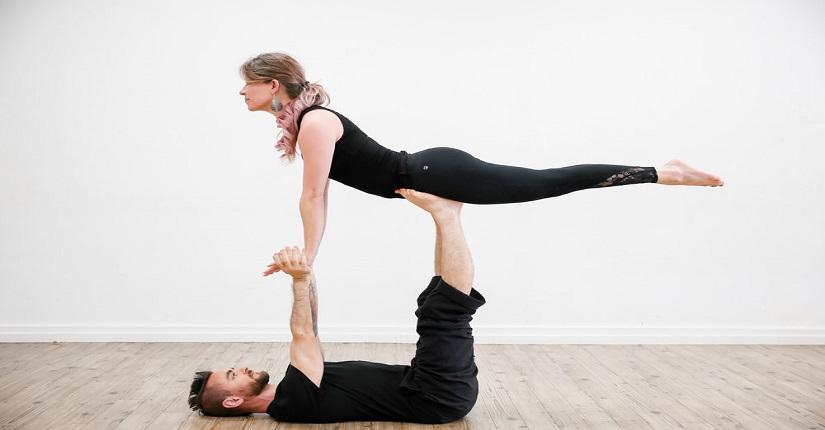
AcroYoga is a form of physical practice that combines acrobatics, yoga, and therapeutic arts. It is typically practiced in pairs or groups and involves a blend of partner acrobatics, yoga poses, and Thai massage techniques. AcroYoga focuses on building trust, communication, and connection between participants.
The practice of AcroYoga can be broken down into three main roles:
Base: The person who remains in contact with the ground, providing a stable foundation for the practice. The base supports and lifts the flyer.
Flyer: The person who is lifted off the ground and moved into various acrobatic positions by the base. The flyer often needs to engage their core and maintain balance.
Spotter: An optional role, the spotter is an additional person who stands nearby to ensure the safety of the base and flyer during more challenging moves. The spotter provides guidance and assistance if needed.
AcroYoga emphasizes communication, trust, and collaboration between participants. It requires a strong sense of body awareness, balance, and flexibility. The practice is known to be both physically demanding and emotionally rewarding, as it fosters a sense of community and connection among practitioners.
How to do AcroYoga
AcroYoga is best learned through structured classes, workshops, or guided sessions led by experienced instructors. If you’re interested in trying AcroYoga, follow these steps to get started:
Find a class or workshop: Look for AcroYoga classes or workshops in your area or nearby communities. Many yoga studios, fitness centers, and AcroYoga communities offer introductory classes for beginners.
Start with a foundation class: If you’re new to AcroYoga, begin with a foundation or beginner-level class. These classes focus on building essential skills, communication, and trust between partners.
Bring a partner or find one: AcroYoga is typically practiced in pairs, so it’s helpful to have a partner to work with. If you don’t have one, check if the class or workshop offers opportunities to pair up with other participants.
Warm-up: Like any physical activity, warm-up before starting AcroYoga to prevent injuries and improve flexibility. Gentle stretches and mobility exercises are beneficial.
Learn the roles: Understand the three main roles in AcroYoga: base, flyer, and spotter. Learn the responsibilities of each role and how to communicate effectively during the practice.
Practice safety and spotting: Safety is paramount in AcroYoga. Learn proper spotting techniques to protect yourself and your partner during challenging moves. Always have a spotter present when attempting more advanced poses.
Start with basic poses: Begin with simple poses and transitions to get comfortable with the movements and build trust with your partner. Some common beginner poses include “Bird,” “Throne,” and “Back Bird.”
Communicate and trust: Open communication between partners is crucial in AcroYoga. Speak openly about your comfort levels, fears, and physical limitations. Trust your partner and develop a strong sense of teamwork.
Progress gradually: As you gain confidence and proficiency, gradually advance to more complex poses and flows. Always prioritize safety and never attempt moves beyond your skill level without proper guidance.
Incorporate therapeutic elements: Explore the therapeutic aspects of AcroYoga, such as Thai massage techniques, to enhance relaxation and healing during the practice.
Benifits of AcroYoga
AcroYoga offers a wide range of physical, mental, and emotional benefits for participants. Here are some of the key advantages of practicing AcroYoga:
Strength and Flexibility: AcroYoga requires participants to engage their muscles, promoting strength and flexibility in both the base and flyer. The dynamic movements and supported stretches help improve overall body flexibility.
Balance and Coordination: AcroYoga challenges individuals to maintain balance and coordination during various poses and transitions. This practice enhances proprioception and body awareness.
Trust and Communication: Working closely with a partner in AcroYoga builds a strong sense of trust and fosters clear communication. Participants learn to listen, communicate effectively, and rely on each other, enhancing interpersonal connections.
Stress Reduction: The practice of AcroYoga involves mindful movement, deep breathing, and partner support, all of which can reduce stress and promote relaxation.
Core Strength: Many AcroYoga poses require active engagement of the core muscles to maintain stability and control. Regular practice helps strengthen the core and improve posture.
Emotional Release: AcroYoga can provide an opportunity for emotional release and expression, especially during therapeutic elements like Thai massage.
Social Connection: AcroYoga often involves group activities, creating a sense of community and belonging. Practitioners can develop strong bonds with their partners and fellow participants.
Playfulness and Joy: AcroYoga encourages a playful and lighthearted approach to movement, fostering a sense of joy and fun during practice.
Improved Body Awareness: Practicing AcroYoga requires participants to be mindful of their body alignment and movements. This heightened body awareness can carry over into everyday life, promoting better posture and alignment.
Increased Self-Confidence: As participants progress in their practice and achieve new poses, they gain a sense of accomplishment and increased self-confidence.
Mind-Body Connection: AcroYoga integrates elements of yoga and acrobatics, promoting a deeper mind-body connection and a sense of being present in the moment.
Empowerment and Support: AcroYoga encourages individuals to step out of their comfort zones, face challenges, and support each other through the process, fostering feelings of empowerment and support.
© Indian Yoga Expert 2025 | All Rights Reserved
© Indian Yoga Expert 2025 | All Rights Reserved